Ordnance come in all shapes and sizes and are each designed to defeat a certain target or to be deployed from a specific platform. Ordnance can be grouped into ten general categories including:
Bombs
Reference "Bombs and Fuzes" Joint Targeting School - http://www.fas.org/man/dod-101/ops/docs/a532/RDG7A-4.htm
Bombs are air dropped munitions ranging in weight from 1 to 3,000 lbs and in length from 2 to 10 feet. There are hundreds of specific bomb configurations but generally speaking bombs all have similar components including a container or body, a fuze or fuzes, a booster and a stabilizing device. Bombs are categorized according to the ratio of explosive weight to total weight. Categories include general purpose (GP), demolition, fragmentation, and penetration. There are also two other common category of bombs including cluster or dispenser bombs and Incendiary or Firebombs
Bomb Classifications
GP Bombs: GP bombs usually have an explosive weight equal to approximately 50 percent of the total weight of the bomb. These bombs normally weigh from 250 to 2000 pounds and produce relatively good blast and fragmentation. GP bombs can be used against a variety of targets. Since the body case is approximately one-half-inch thick, the casing creates a fragmentation effect at the moment of detonation. Also, since the explosive filler constitutes approximately 50 percent of the total weight, considerable damage from the blast effect can be expected at the point of detonation. In addition to these effects, a mining effect can be gained through the use of delayed-action fuzes. GP bombs can be made into a semi-armor piercing bomb by retaining the original nose closure plug and installing only a tail fuze. This configuration will penetrate medium hard targets. This bomb type was given the designation GP because of its versatility.GP bombs are all cylindrical in shape and are equipped with conical fins or retarders. They are adapted for both nose and tail fuzes to ensure reliability and to cause the desired effects. GP bombs in the current inventory are all similar in construction. The most common GP bombs are the MK 80 Series which include the MK 82 ( 500 pound class), the MK 83 (1000 pound class) and the MK 84 (2000 pound class) The MK 82 in the cut-away figure below serves as a typical example.
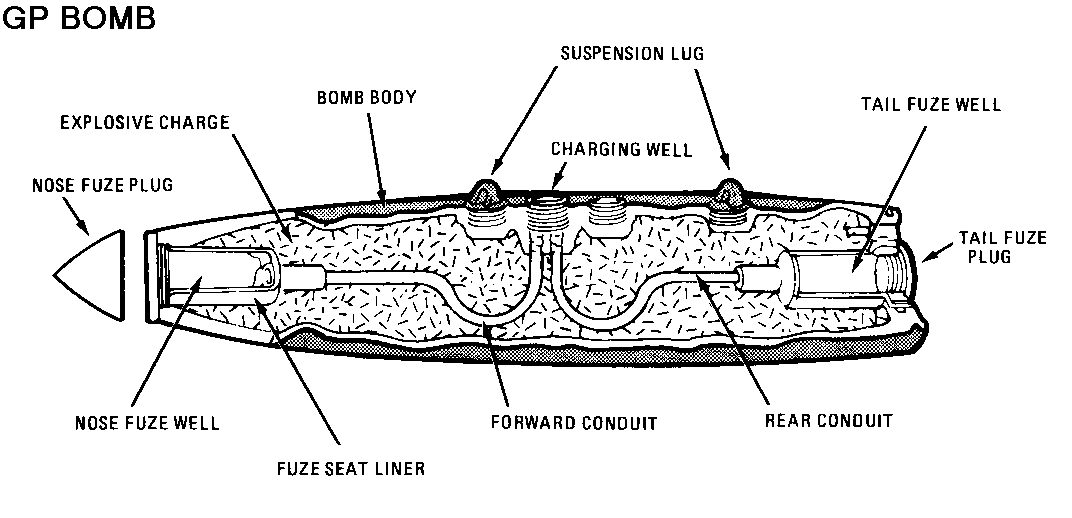
Demolition Bombs: Demolition bombs have an explosive weight equal to approximately 65 to 80 percent of the total weight. These bombs have a relatively thin-walled casing to maximize blast effects while penetration and fragmentation effects are limited.
Fragmentation Bombs: These bombs are intended to disperse and project high-velocity fragments. The fragments are the principle damage mechanism of the weapons, with blast effects being a secondary consideration. The charge to total weight ratio varies from 10 to 20 percent. No bombs presently in the inventory are primarily fragmentation bombs although GP bombs do produce a relatively good fragmentation effect.
Penetration Bombs: These bombs are designed to penetrate and explode inside a hard target such as a concrete bunker. They are built with heavy cases and are aerodynamically designed to counter break-up. The explosive charge is approximately 25 to 30 percent of the total weight. The AGM-65 Maverick missile and the BLU-109 are good examples of penetrating munitions.
Cluster Bomb Unit (CBU) CBUs and dispensers are bombs that are loaded with a payload of submunitions . Some CBUs and dispensers can hold up to a couple of hundred submunitions inside. CBUs are usually dropped from an aircraft and have a fuzing mechanism which breaks open the CBU at a pre-determined time or altitude and distributes the submunitions on the intended target. Dispensers usually are configured to stay attached to the aircraft and eject individual submunitions out one at a time in a rapid motion. The first image below shows a CBU and the aircraft and the second picture is a close up of the same CBU just after the fuze is activated separating the clam shell like thin cased body apart dispersing the submunitions. Sometimes on a range you'll find CBU containers that failed to open and stuck inside are the submunitions. CBU containers should be approached with caution because even if the fuze functions and body has CBU container has separated there still maybe 1 or 2 submunitions that did not break free from the container while in flight. These hung submunitions can be very dangerous and deadly if the CBU container is disturbed.
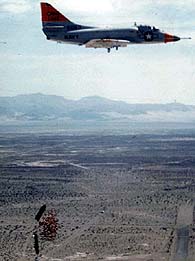 | 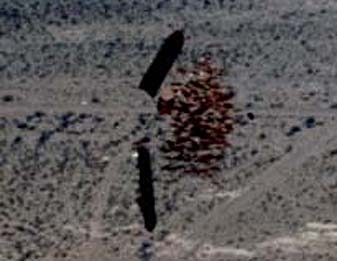 |
Incendiary/Firebombs: With incendiary and firebombs fire is effective in interrupting operations of enemy personnel and in damaging supplies stored in the open. Incendiaries produce intense, localized heat designed to ignite adjacent combustible target materials. The true incendiary produces no fireball and relatively little flame. Firebombs: the basic damage mechanism of firebombs weapons comes from the fireball and burning residual fuel globules, impact momentum of the fuel and container, and damage from fires started by the weapon. The sharp cutoff of casualty-producing mechanisms outside the incendiary pattern allows delivery close to friendly troops, usually parallel to the forward line of battle, with minimum risk. Firebombs are sometimes referred to as fuel air explosive or FAE bombs.
Bomb Effects
Blast: The blast is caused by tremendous overpressures generated by the detonation of a high explosive. Complete detonation of high explosives can generate pressures up to 700 tons per square inch and temperatures in the range of 3,000 to 4,500º prior to bomb case fragmentation. Approximately half of the total energy generated will be used in swelling the bomb casing to 1.5 times its normal size prior to the fragmenting and then imparting velocity to those fragments. The remainder of this energy is expended in compression of the air surrounding the bomb and is responsible for the blast effect. This effect is most desirable for attacking walls, collapsing roofs, and destroying or damaging machinery. The effect of blast on personnel is confined to a relatively short distance (110 feet for a 2000 pound bomb). Blast is maximized by using a GP bomb with a fuzing system that will produce a surface burst with little or no confinement of the overpressures generated.
Fragmentation: Fragmentation is caused by the break-up of the weapon casing upon detonation. Fragments of a bomb case can achieve velocities from 3,000 to 11,000 feet/second (fps) depending on the type of bomb (for example GP bomb fragments have velocities of 5,000 to 9,000 fps). Fragmentation is effective against troops, vehicles, aircraft and other soft targets. The fragmentation generated from the detonation of a high-explosive bomb has greater effective range than blast, up to approximately 3,000 feet for a typical GP bomb. The fragmentation effect can be maximized by using a bomb specifically designed for this effect, or by using a GP bomb with an airburst functioning fuze.
Cratering: Cratering can be accomplished by using a GP bomb with a delayed fuzing system. This system allows bomb penetration before the explosion occurs and permits the formation of a larger crater as a result. This effect is most desirable in interdiction of supply routes and area denial operations. It is also applicable in attacks on multiple-storied buildings. Rather than functioning the bomb instantaneously on impact with the roof of a building, the delayed fuzing allows the bomb to penetrate and use the confinement of the building walls to increase the destructive effect of the bomb.
Armor Penetration: Armor penetrating bombs are effective for damaging tanks, assault guns, armored personnel carriers, and other armored targets. Accomplished by shaped charges or kinetic energy penetrators. A major problem associated with both shaped charges and kinetic energy penetrators is the lack of damage visible to the follow-on attacker. This may result in repeated attacks to produce battlefield evidence that a target is no longer a threat.
Projectiles
Projectiles are typically deployed from ground gun platforms but in certain configurations the guns can be mounted on an aircraft. Projectiles range from 20mm to 406mm in diameter and from 83mm to just over 1 meter in length. Typical projectile configurations consist of a bullet shaped metal body, a fuze and a stabilizing assembly. Fillers include antipersonnel submunitions, high explosives, illumination, smoke, white phosphorus, riot control agent or a chemical filler. Fuzing may be located in the nose or base. Fuze types include proximity, impact and time delay depending upon the mission and intended target. Stabilization is achieved by either a fin assembly attached to the base or the body or are spin stabilized. Spin stabilized ordnance contain a soft metal (usually copper) rotating band around the body usually near the base. On spin stabilized systems the gun bores are rifled. The raised surfaces of the rifling are called "lands" which cause the projectile to spin as it progresses down the gun tube. As the projectile is following the lands of the barrel the rotating band(s) are engraved by the rifling. The spinning motion stabilizes the projectile in flight. One way to determine if an ordnance item has been fired is to look at the rotating bands for signs of engraving.
Typical U.S. Projectiles Sizes Include:
- 20 mm
- 30 mm
- 40 mm
- 75 mm
- 90 mm
- 5 inch
- 105 mm
- 106 mm
- 120 mm
- 8 inch
- 155 mm
Top
Mortars
| Mortars range from 1 to 11 inches in diameter and resemble projectiles although they usually contain a thinner body casing. Mortars can be filled with explosives, chemicals, white phosphorus or illumination flares. Mortars are launched from gun tubes where the propellant charges are usually loaded separately from the mortar round. Typical U.S. sizes include the 60mm, 81mm and 4.2 inch mortars. The photo to the right was taken from the 3-volume history of the Chemical Warfare Service published in 1959 by the Army's Office of Military History and shows a 4.2-inch chemical mortar in action, Sep 1943 during WWII. Mortars like projectiles can either be fin stabilized or spin stabilized. |  |
Rockets
| Rockets are self-propelled ordnance ranging from 37 to more than 380mm in diameter and measure from 1 foot to 9 feet in length. Rockets are ordnance that use gas pressure from rapidly burning propellant to transport a payload (warhead) to a desired target. Rockets consist of a warhead, a motor, fuze and a stabilizing mechanism. Rockets are unguided after launch and are stabilized by canted nozzles at the base of the motor or fins attached to the motor. Rockets are put together in sections in is not uncommon to find rocket motors, warheads and fuzes on a range by themselves. Rocket motors can be hazardous because of the potential for un-burned propellant. The warhead section of the rocket is the section that is designed to produce the desired end effect on the target. Rocket warheads can be filled with high explosives, white phosphorus, submunitions, riot-control agent, illumination flares or toxic chemicals. The fuze mechanisms on rockets include impact, time delay, or proximity. The 2.75 inch rocket with a variety of different warheads is shown in the photo to the left. The 2.75 inch rocket has a motor, a stabilizing assembly (the small fins at the rear of the rocket), a warhead and a fuze. The warheads on the 2.75 inch rocket are interchangeable so users can fire and HE or practice warhead from the same platform. |  |
Guided Missiles
Guided Missiles resemble rockets however, they are guided to their target by various guidance systems. Guidance systems uses internal or external radar, video, laser or wire guides depending upon the particular configuration of the missile. Guided missiles have features such as fins and mini-propellant motors which guide the missile to the target. Guided missile also pose a secondary hazard because they may contain residual propellant that could ignite and burn violently. Shown in the photo to the right (from defenselink.com) is the Tube Launched, Optically Tracked, Wire Guided (TOW) Missile. The original TOW missile had a diameter of 5 inches and a range of 3000 meters. Considerable improvements have been made to the missile since 1970. The Improved TOW (ITOW) was delivered in 1982. This missile has a 5-inch diameter warhead, and includes an extended probe for greater standoff and penetration. An enhanced flight motor was included in the ITOW, increasing the missile's range to 3750 meters. TOW Missiles are guided to their target by thin wires that transmit in flight corrections to the missile from the launcher as it is enroute to the target. The average cost of a TOW missile is around $180,000. | 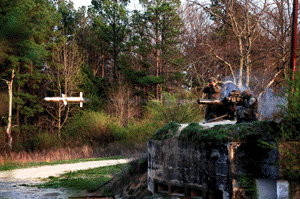 |
Landmines
Landmines are unique in the fact that they are designed to remain unexploded until acted upon, influenced, or a pre determined amount of time passes. Landmines are often times discussed separately from UXO because of the fact that UXO remain unexploded not by design but by a failure in the delivery, functioning mechanism or other problems. There are hundreds of different types of mines, most of which can be grouped into one of three categories including anti-personnel, anti-tank, or anti-material. Mines can be made of metal, plastic, wood or even cloth. Mines can be very dangerous and contain very sensitive fuzes. Typical fuze mechanisms include pull, pressure, pressure release, and influence. Landmines can remain active for years and remain one of the largest killers throughout the world. Some figures estimate that more than 110 million active mines are scattered in 68 countries with an equal number stockpiled around the world waiting to be planted. The largest problem is in areas such as Cambodia where landmines have been laid for years. Some landmines cost under $2 to produce and are easily to deploy. The U.S. still uses landmines including the Claymore mine, the M15 and M16 (shown) anti-tank mines. UXOInfo.com will address landmine issues in the site and as the information grows we are looking to expand the site to have sections dedicated to the landmine problem. | 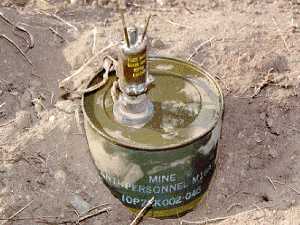 |
Grenades
Grenades are classified according to their type, use and function. There are three major types of grenades including hand grenades, rifle grenades and projected grenades. Hand grenades are deployed by troops by throwing the grenade at an enemy target. Grenades may be used as antipersonnel, antitank, smoke, incendiary, chemical, target practice and illumination weapons. All hand grenades have three main parts including a body, a fuze (usually with a pull safety ring) and a filler. Fragmentation grenades are the most common type of hand grenade deployed. Fragmentation grenades have a metal body filled with an explosive material. When the filler explodes the body of the grenade or a fragment sleeve breaks into small, lethal, high velocity fragments that are scattered. Hand grenades usually have pyrotechnic delay fuzes that take 3-5 seconds to burn and activate the filler after the safety lever is released. The grenade pictured is a U.S. MKII Fragmentation grenade. | 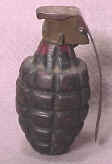 |
Rifle grenades are grenades that are designed to be deployed from standard infantry rifles. They range from 9 to 17 inches and length and resemble a mortar. Rifle grenades may be filled with high explosives, white phosphorous, riot-control agent, illumination or smoke. Rifles grenades have impact fuzes located on the nose or internally behind the warhead.
Projected grenades are grenades that are projected from a specially designed gun platform. The most common size projected grenade is the 40mm grenade. A single 40mm grenade is a little larger than an egg but can contain high explosives and are usually have very sensitive internal impact fuzing systems.
Submunitions
| Submunitions are ordnance that are payloads to larger ordnance such as cluster bombs, dispensers, 155 mm projectiles and some rockets that scatter the submunitions across an area when deployed. Submunitions include bomblets, grenades and mines that are filled with explosives or chemical agents. Submunitions are considered the most hazardous category of ordnance because they can contain very sensitive fuzing systems. Submunitions come in many sizes and shapes and have a variety of configurations and features. Some are stabilized by arming ribbons, parachutes or fin assemblies. The submunition shown is a M118 or otherwise commonly known as a "Rockeye". This submunition in particular is extremely hazardous because of it's sensitive fuzing. Often times on ranges you will find these ordnance stuck into the ground which makes positive identification very difficult. Some of the practice Rockeye submunitions are painted orange so they may also be referred to as carrots. Submunitions can be anti-personnel, anti-material, or area denial and are very effective in covering large areas because of the amounts that are deployed in a single cluster bomb unit or container. | 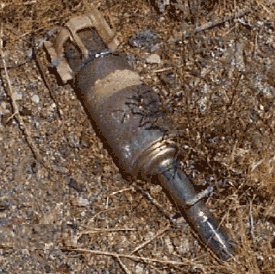 |
Underwater Ordnance
Underwater ordnance includes torpedoes and mines including sea mines and limpet mines. Torpedoes are self-propelling ordnance that are launced into the water against ships, submarines, or other water targets. Sea mines are mines that are deployed in the sea for use on water targets such as ships and submarines. Limpet mines are encased explosive charges that are attached to side of ship hulls and are usually time detonated. Limpet mines can also be used on land targets such as storage tanks and buildings. Underwater UXO is a major but often ignored problem in the industry. The military spends a significant amount of funding on technologies to locate underwater UXO every year but in general, large-scale underwater clearances are not done. Small-scale clearances are sometimes done with trained EOD divers. Fishing boats have been in the news over the years because they have pulled up old torpedoes and sea mines from their fishing nets sometimes with severe consequences. UXOInfo.com believes that underwater UXO will eventually get more attention and funding as technology and progress is made on the land based UXO problem. UXOInfo.com plans to expand the underwater section in the future.
Top
Small Arms
Small Arms ammunition is ammunition that is less than 20mm in caliber and no longer than 4 inches. Small Arms ammunition is fired from pistols, rifles, shot guns and machine guns. Generally small arms shell casings are made from brass or steel and contain lead, steel, depleted uranium, incendiary or tracer material. Although small arms are considered the least hazardous ordnance category unexploded small arms ammunition can still be dangerous especially when subjected to shock, heat or impact.
Top
| Ordnance Start Page | Ordnance Fuzing | Ordnance Photo Gallery |
| Ordnance Categories | Weapons Deployment | Ordnance Hazards |









